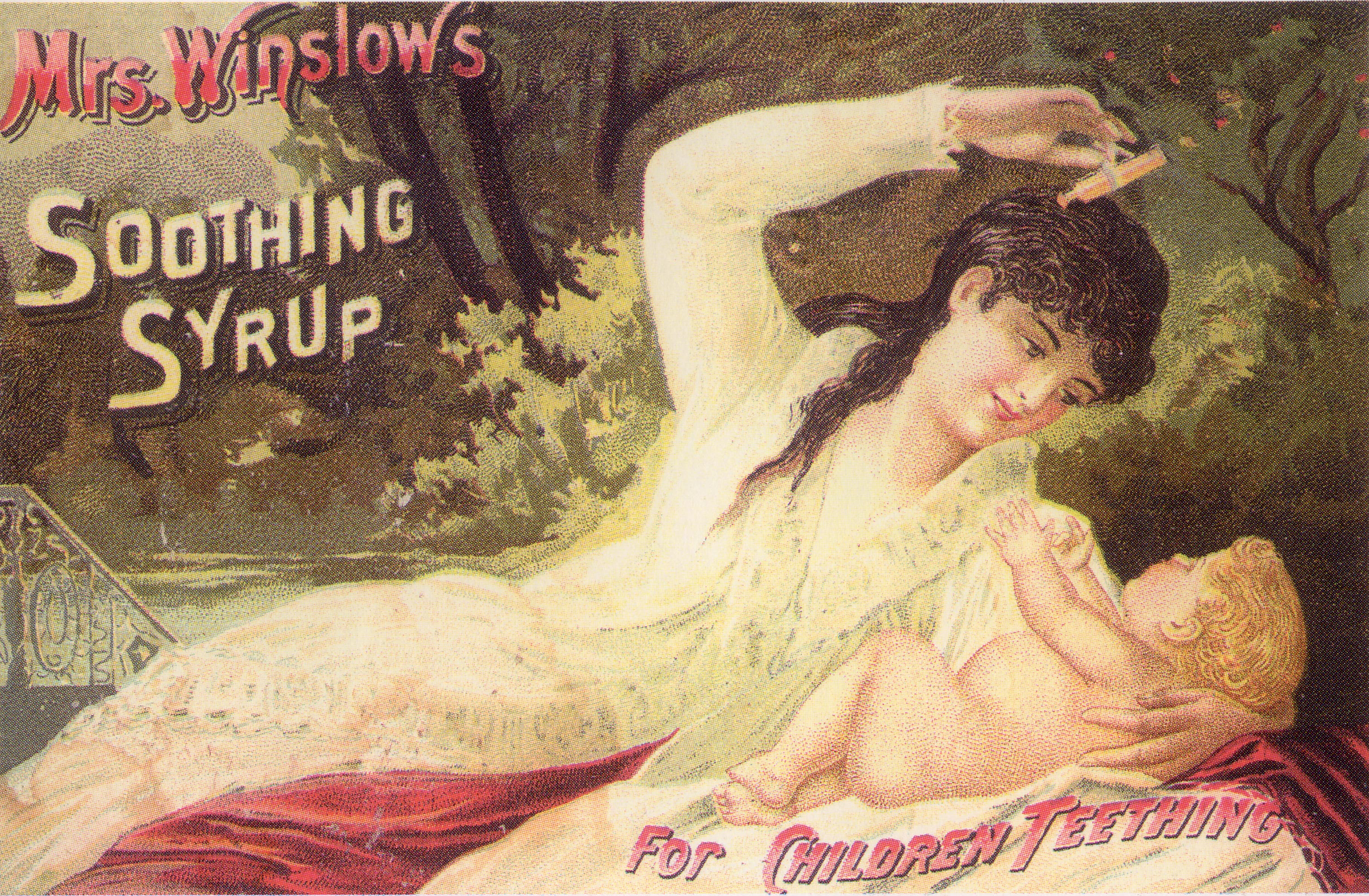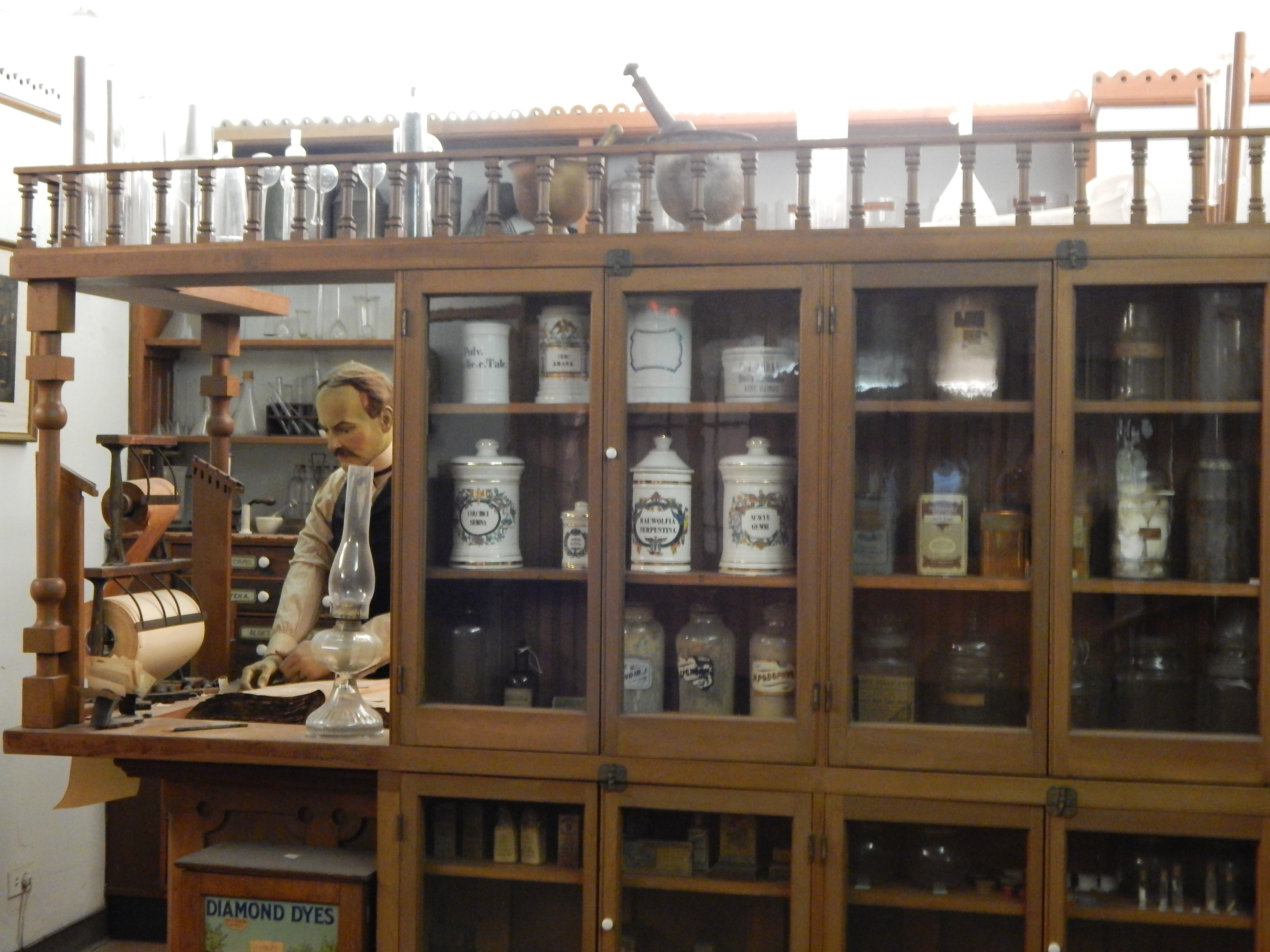Published by Education Intern, Lillian Climo

Patent medicine trading card. Mrs. Winslow’s Soothing Syrup, c. 1887. Miami University Libraries Digital Collections. Advertisement for “Mrs. Winslow’s Soothing Syrup”, from 1887. The syrup is advertised as a cure for teething and shows a mother administering the medicine to her infant in a peaceful outdoor setting.
Patent medicines were sold as over the counter medications often using ingredients that we know today to be harmful (such as opioids or alcohol). One such example was Mrs. Winslow’s Soothing Syrup, which was developed in 1845 by Jeremiah Curtis and Benjamin A. Perkins (Wood Library Museum). The medicine was advertised mainly as a cure for infant teething but was also used to cure common colds, the flu, and colic (Howard). The remedy was named after Curtis’ mother-in-law, a woman called Charlotte N. Winslow, who apparently created this recipe while working as an infant nurse. The two main ingredients used in Mrs. Winslow’s were morphine and alcohol (Wood Library Museum). As a result, Mrs. Winslow’s could cause addiction, comas, or even death in very young children (Christen and Christen).
During the mid to late 1800s, there were a number of genuinely harmful soothing syrups advertised to parents as completely safe for their infants. While Mrs. Winslow’s was one of the most famous, selling over 1.5 million bottles a year by 1868, (Wood Library Museum), similar and equally dangerous medicines were available across the world. For example, “Harrop’s Soothing Syrup” was documented in 1875 by a British doctor for falsely advertising how safe it was. Dr. Joseph Morris explained that doctors often met mothers who had administered the remedy to their children unaware of what was actually in the syrup. In one instance Morris’ records involved a mother who explained that the advertisement for Harrop’s assured many times that the medication was safe for infants (Morris). The explanation for how to administer proper doses was not in any of the pamphlets that the mother had carefully read. Rather, this information was almost hidden in the packaging, found on a small piece of paper folded into the bottle. As a result of the syrup’s high concentration of morphine, her child eventually died of an opiate overdose. Dr. Morris used this case to argue that these types of soothing syrups should never be available to children so young (Morris).

Patent medicine trading card. Mrs. Winslow’s Soothing Syrup, c. 1886. Miami University Libraries – Digital Collections. A second advertisement for “Mrs. Winslow’s Soothing Syrup” from 1886. In this image, a mother sits in bed with her two children while reading advertising for the syrup. The actual medicine is on the bedside table and has either just been given to the children or is about to be given to the children.
Mrs. Winslow’s was infamous in the U.S. for cases very similar to those documented by Dr. Morris. The advertising and packaging of the medicine were likely intentionally misleading. Mrs. Winslow’s Soothing Syrup often showed an idealized image of a mother and child, projecting an idea of safety (Howard). Additionally, through much of the 1800s, labels were not required to fully disclose the ingredients in these types of medication (Wood Library Museum). Beyond labeling that hid the dangerous elements of the syrup, the suggested dosage was ridiculously high stating that children older than six months should take a teaspoon of Mrs. Winslow’s up to four times a day (Strongman). It was for this reason that the syrup was nicknamed “the baby killer” as even one teaspoon could kill the average infant (Strongman). However, because the syrup was not often believed to be the cause of death, there are no statistics for how many children died as a result of it. Some accounts have claimed that the number may be in the thousands (Strongman).
The deaths caused by Mrs. Winslow’s are sometimes cited as a reason why the Pure Food and Drug Act (a predecessor to the FDA) was enacted (Howard). This Act which passed in 1906, prohibited the sale of poisonous medication and forced drugs to label their ingredients. However, there was still limited knowledge around how harmful certain drugs were and thus, cocaine and opium were permitted with proper labeling (Howard). Additionally, Mrs. Winslow’s was forced to remove the term “soothing” from their name, and morphine was eventually taken out of the recipe (Strongman). As the years went on, the popularity and general trust in Mrs. Winslow’s severely declined. Five years after the Pure Food and Drug Act was passed, the American Medical Association stated that the medication was unsafe and illegitimate. Still, there are cases of Mrs. Winslow’s being sold up until the 1930s (Wood Library Museum.).

Apothecary Exhibit at the International Museum of Surgical Science. This image is from the IMSS Apothecary exhibit, which recreates a nineteenth-century apothecary. This time period was particularly known for patent medicines such as Mrs. Winslow’s.
Works Cited:
Christen, AG, and JA Christen. “Sozodont Powder Dentifrice and Mrs. Winslow’s Soothing Syrup: Dental Nostrums. Christen AG1, Christen JA.” Journal of the History of Dentistry, Nov. 2000, pp. 99–105.
Howard, Sherrel G. Drugs of Abuse: Pharmacology and Molecular Mechanisms. Wiley, 2014.
Morris, Joseph. “The Use of ‘Soothing Syrups.’” The British Medical Journal, 30 Oct. 1875.
Wood Library Museum. “Mrs. Winslow’s Soothing Syrup.” Wood Library Museum, 2019, www.woodlibrarymuseum.org/museum/item/529/mrs.-winslow%27s-soothing-syrup
Strongman, Alysha. “Mrs. Winslow’s Soothing Syrup: The Baby Killer.” Museum of Health Care Blog, 28 July 2017, museumofhealthcare.wordpress.com/2017/07/28/mrs-winslows-soothing-syrup-the-baby-killer/.
Lillian Climo was the Fall 2019 Education Intern at the International Museum of Surgical Science. She studies Printmedia and Visual and Critical Studies at the School of the Art Institute of Chicago. Her interests include the history of women in medicine and the study of art objects.


